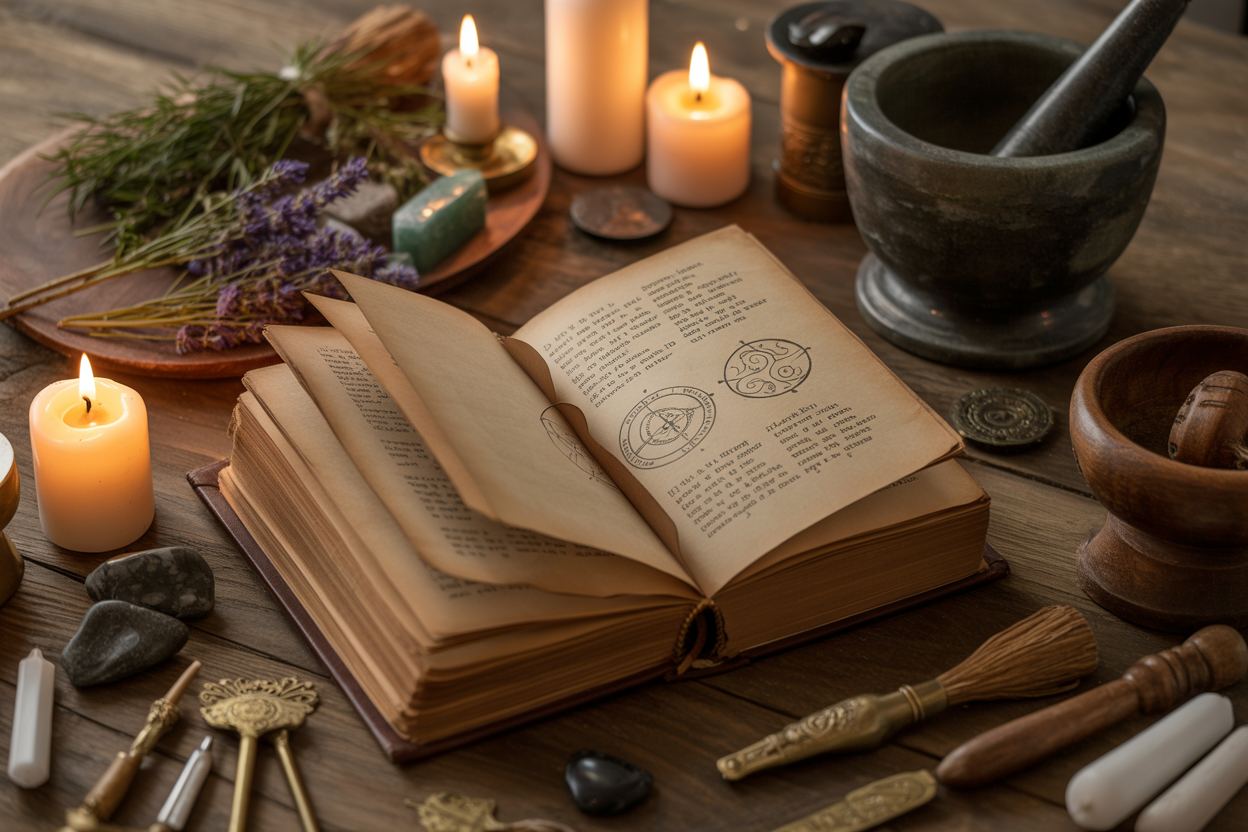Table of Contents
Millions of people around the world practice witchcraft, but the question of whether it’s “real” depends entirely on how you define it. This guide is for anyone curious about modern witchcraft, skeptics seeking scientific perspectives, and practitioners wanting to understand different viewpoints on their craft.
We’ll examine what witchcraft actually means today and why definitions vary so widely between cultures and individuals. You’ll discover what scientific research reveals about magical practices and which elements of witchcraft have measurable, practical benefits. We’ll also explore how personal beliefs shape experiences with magic and why cultural context matters when evaluating supernatural claims.
The answer isn’t simply yes or no – it’s far more interesting than that.
Understanding Different Definitions of Witchcraft
Historical Practices and Folk Traditions Across Cultures
Witchcraft has existed in countless forms across every human civilization, with each culture developing its own unique understanding of magical practices. In ancient Egypt, priests and priestesses worked with elaborate rituals involving herbs, crystals, and invocations to deities like Isis and Thoth. Celtic druids practiced what many would consider witchcraft today, using plant medicine, divination, and seasonal ceremonies to connect with nature’s cycles.
African traditional religions brought rich magical traditions involving ancestor worship, herbal healing, and spiritual communication through various forms of divination. These practices traveled across oceans through the slave trade, blending with indigenous American traditions and European folk magic to create unique systems like Hoodoo and Santeria.
European folk magic included hedge witchery, where village wise women served as healers and midwives, using herbal remedies and charms. Scandinavian traditions gave us seidr magic, while Slavic cultures developed their own forms of household magic and protective rituals.
| Region | Primary Focus | Key Elements |
|---|---|---|
| Celtic | Nature connection | Herbs, stones, seasonal rituals |
| African | Ancestor communication | Divination, spiritual mediumship |
| European | Folk healing | Herbalism, charms, midwifery |
| Indigenous American | Shamanic practices | Vision quests, plant medicine |
Modern Wiccan and Neo-Pagan Movements
The 20th century brought a revival of witchcraft through movements like Wicca, founded by Gerald Gardner in the 1950s. Modern Wicca emphasizes the worship of a Goddess and God, following the Wheel of the Year with eight seasonal celebrations called sabbats. Practitioners focus on harmony with nature, ethical guidelines like “harm none,” and personal spiritual development through ritual and spellwork.
Neo-paganism encompasses a broader range of earth-based spiritual practices, including Norse Heathenry, Celtic Reconstructionism, and Hellenic Polytheism. These movements attempt to reconstruct ancient religious practices using historical research combined with modern spiritual needs.
Contemporary witchcraft also includes eclectic practitioners who draw from multiple traditions, creating personalized spiritual paths. Many modern witches focus on self-empowerment, manifesting goals through intention and ritual, and developing intuitive abilities.
The internet has transformed how people learn about witchcraft, creating online communities and making information more accessible than ever before. This has led to diverse interpretations and practices, from traditional coven-based worship to solitary practitioners working entirely alone.
Hollywood Portrayals Versus Authentic Practices
Popular media has created wildly inaccurate expectations about what witchcraft actually involves. Movies and TV shows typically portray witches as either evil hags casting curses or young women shooting sparks from their fingertips. Real witchcraft looks nothing like this dramatic fiction.
Authentic magical practice involves quiet study, meditation, herbalism, and personal spiritual development. Instead of flashy special effects, real witches might spend hours researching lunar phases, growing herbs, or crafting handmade tools. The work is often subtle, focusing on internal transformation and gradual life improvements rather than instant supernatural results.
Hollywood’s emphasis on conflict and supernatural drama has created misconceptions about witches being inherently dangerous or power-hungry. Most practitioners view their craft as a healing spiritual path focused on personal growth and helping others. The real magic happens through changed perspectives, increased confidence, and deeper connection to natural rhythms.
Religious and Spiritual Frameworks Surrounding Witchcraft
Different witchcraft traditions operate within vastly different spiritual frameworks. Some practitioners work within polytheistic systems, honoring multiple deities from various pantheons. Others follow duotheistic paths focusing on masculine and feminine divine principles, while some maintain purely naturalistic approaches without personified deities.
Many witches incorporate elements from established religions, creating syncretic practices. You’ll find Christian witches who blend folk magic with biblical traditions, Buddhist witches incorporating mindfulness and karma concepts, and Jewish witches drawing from Kabbalah and folk practices.
The framework chosen significantly influences how someone practices witchcraft. A Norse-influenced practitioner might focus on runes and working with specific gods like Odin or Freyja, while someone following a Celtic path might emphasize seasonal celebrations and working with land spirits.
Some practitioners view witchcraft as purely psychological, using rituals and symbols to access subconscious resources and create mental shifts. Others believe in literal spiritual forces and entities they can petition or work with directly. These different frameworks create remarkably diverse approaches to what gets called “witchcraft.”
Scientific Evidence and Skeptical Analysis
Lack of Reproducible Supernatural Phenomena in Controlled Studies
When researchers examine claims of supernatural witchcraft abilities under rigorous laboratory conditions, the results consistently show no evidence of paranormal effects. Major institutions like the James Randi Educational Foundation have offered substantial monetary rewards for anyone who can demonstrate supernatural abilities under controlled scientific testing – yet no one has successfully claimed these prizes despite thousands of attempts.
Studies testing psychic phenomena, spell-casting, and energy manipulation have repeatedly failed to produce results that exceed statistical chance. For example, experiments examining whether practitioners can influence random number generators, affect plant growth through intention, or demonstrate telepathic abilities show no significant effects when proper controls are implemented. The key issue lies in experimental design – when variables like cold reading, sensory cues, and experimenter bias are eliminated, the supposed magical effects disappear entirely.
Even large-scale meta-analyses reviewing hundreds of parapsychology studies find that any positive results typically stem from methodological flaws rather than genuine supernatural phenomena. The scientific method requires that extraordinary claims be supported by extraordinary evidence, and this standard has not been met by witchcraft’s supernatural claims.
Psychological Explanations for Perceived Magical Effects
The human brain exhibits fascinating quirks that can make ordinary events feel magical. Pattern recognition systems that helped our ancestors survive now sometimes create connections where none exist. When someone performs a ritual and later experiences a positive outcome, the brain naturally links these events even when they’re completely unrelated.
The placebo effect plays a massive role in perceived magical success. Studies show that believing in a treatment’s effectiveness can trigger real physiological changes – reduced pain, improved mood, and enhanced immune function. Rituals and spells often incorporate elements that naturally promote these positive psychological states: meditation, focused intention, symbolic meaning, and community support.
Cognitive biases also shape how people interpret their experiences:
- Selective attention causes practitioners to notice events that seem to confirm their beliefs while overlooking contradictory evidence
- Post-hoc rationalization leads people to reinterpret random events as meaningful magical outcomes
- The availability heuristic makes memorable coincidences seem more frequent and significant than they actually are
Social psychology explains much of witchcraft’s appeal through group dynamics, shared identity formation, and the powerful psychological benefits of belonging to a community with shared beliefs and practices.
The Role of Confirmation Bias in Witchcraft Beliefs
Confirmation bias represents perhaps the strongest psychological force maintaining belief in supernatural witchcraft. This mental shortcut causes people to seek information that supports their existing beliefs while avoiding or dismissing contradictory evidence. Once someone believes in magical practices, they unconsciously filter their experiences to reinforce this worldview.
Practitioners often keep detailed records of their magical workings, but these journals typically emphasize apparent successes while downplaying or forgetting failures. A love spell that precedes meeting someone new gets remembered and celebrated, while dozens of unsuccessful attempts fade from memory. This creates a distorted personal database that seems to prove magic’s effectiveness.
The internet amplifies confirmation bias by creating echo chambers where believers share success stories and validate each other’s experiences. Online communities rarely discuss failed spells or critically examine their practices, instead focusing on positive testimonials and elaborate explanations for why magic sometimes doesn’t work.
| Confirmation Bias Examples in Witchcraft | Reality Check |
|---|---|
| “My protection spell worked – nothing bad happened today” | Most days pass without major problems regardless of magical intervention |
| “I cast a money spell and found $20 on the street” | People find money occasionally through pure chance |
| “My healing ritual helped my cold go away faster” | Colds resolve naturally within predictable timeframes |
Breaking through confirmation bias requires actively seeking disconfirming evidence and applying the same critical thinking standards to magical claims as to any other extraordinary assertion.
Cultural and Anthropological Perspectives
Witchcraft as Social Construct in Different Societies
Across the globe, witchcraft manifests differently depending on cultural context and social needs. In West African traditions, practitioners often serve as healers and spiritual mediators, wielding respect within their communities. The Yoruba babalawo or Akan okomfo holds positions of authority, consulted for everything from illness to major life decisions.
Indigenous communities in the Americas view magical practices as integral to maintaining balance between human and natural worlds. Curanderismo in Mexican culture blends pre-Columbian beliefs with Catholic influences, creating unique healing traditions passed down through generations. Shamanic practices among Native American groups emphasize connection to ancestral spirits and the land itself.
European folk traditions evolved into what we recognize as modern witchcraft, though these practices varied dramatically by region. Norse seidr differed significantly from Mediterranean strega traditions, each reflecting local beliefs about divine forces and supernatural power.
Contemporary Western witchcraft often borrows from these diverse traditions, sometimes controversially appropriating sacred practices from closed cultures. This modern reconstruction illustrates how societies continually redefine and reshape magical beliefs to meet contemporary psychological and social needs.
Function of Magical Thinking in Human Psychology
Magical thinking serves crucial psychological functions that explain its persistence across cultures and historical periods. When faced with uncertainty or lack of control, humans naturally seek patterns and causal connections, even where none exist scientifically.
Ritual practices provide a sense of agency in situations where practical action proves insufficient. A job seeker might perform candle magic not because flames manipulate reality, but because the ritual helps reduce anxiety and increase confidence during interviews. The psychological preparation becomes the actual mechanism of change.
Magical thinking also helps process trauma and grief. Creating meaningful narratives around loss or suffering allows people to maintain hope and find purpose in difficult circumstances. Ancestor veneration practices comfort the bereaved while maintaining family connections across generations.
Research shows that magical thinking activates the same neural pathways as religious experience, triggering releases of neurotransmitters associated with well-being and social bonding. This neurological response explains why magical practices feel genuinely transformative to practitioners, regardless of their objective reality.
Community Bonding Through Shared Spiritual Practices
Witchcraft and magical practices create powerful social bonds within communities. Group rituals synchronize participants’ breathing, heart rates, and brain waves, producing feelings of unity and collective identity. These physiological changes strengthen interpersonal connections and group cohesion.
Modern pagan communities often form around shared magical practices, creating chosen families for people who feel disconnected from mainstream religious institutions. Coven structures provide intimate support networks where members share personal struggles and celebrate achievements together.
Online witchcraft communities have expanded these bonding opportunities globally. Social media platforms allow practitioners to share experiences, seek advice, and participate in virtual rituals with people worldwide. These digital covens offer belonging to individuals in areas where alternative spirituality remains stigmatized.
Seasonal celebrations like solstices and equinoxes give communities regular opportunities to gather and reinforce social bonds. These cyclical observances create shared memories and traditions that strengthen group identity over time.
Historical Persecution and Its Impact on Modern Practices
The European witch trials of the 15th-17th centuries created lasting trauma that shapes contemporary witchcraft practices. An estimated 40,000-60,000 people died during this period, mostly women accused of supernatural crimes. This persecution forced magical traditions underground, where they survived in fragmented forms.
The witch trials weren’t actually targeting ancient pagan religions, as many modern practitioners believe. Most victims were Christians caught in religious, social, and political conflicts. However, the historical narrative of persecution has become central to modern witch identity, creating a sense of inherited trauma and resistance to authority.
Contemporary practitioners often emphasize secrecy and protective measures, echoing historical survival strategies. Many use pseudonyms, avoid public displays of their beliefs, and maintain “broom closet” secrecy about their practices. This defensive posture persists even in legally tolerant societies.
The feminist movement of the 1960s-70s reclaimed the witch archetype as a symbol of female power and independence. This reframing transformed the witch from an evil outsider to an empowered woman resisting patriarchal oppression. Modern witchcraft movements often explicitly connect their practices to women’s rights and social justice causes.
Religious persecution in some regions continues today, with accusations of witchcraft used to target vulnerable populations. These ongoing conflicts influence how contemporary practitioners view their relationship to mainstream society and government institutions.
Practical Elements That Actually Work
Herbal remedies with documented medicinal properties
Many plants traditionally used in witchcraft practices have legitimate medicinal properties backed by scientific research. Willow bark, long associated with healing magic, contains salicin—the precursor to aspirin. Ancient practitioners who brewed willow bark tea for pain relief were actually creating an effective anti-inflammatory treatment.
Echinacea, frequently used in protective and healing spells, genuinely supports immune system function. Studies show it can reduce the severity and duration of common cold symptoms. Similarly, lavender’s reputation in calming rituals aligns with its proven anxiolytic and sleep-promoting effects.
St. John’s Wort, traditionally gathered during the summer solstice for protection magic, has demonstrated efficacy in treating mild to moderate depression. Ginkgo leaves, used in memory enhancement rituals, actually improve cognitive function and circulation.
| Herb | Traditional Use | Scientific Backing |
|---|---|---|
| Chamomile | Calming spells | Reduces anxiety, promotes sleep |
| Turmeric | Protection rituals | Anti-inflammatory, antioxidant |
| Ginger | Energy work | Anti-nausea, digestive aid |
| Garlic | Banishing negativity | Antimicrobial, cardiovascular benefits |
The key difference between traditional herbalism and modern medicine often lies in dosage, preparation, and quality control rather than the fundamental properties of the plants themselves.
Meditation and mindfulness techniques in rituals
Ritual practices involving meditation and mindfulness produce measurable psychological and physiological benefits. When witchcraft practitioners enter meditative states during ceremonies, they’re accessing the same neural pathways that reduce stress hormones and activate the parasympathetic nervous system.
Focused breathing techniques common in spell work mirror established mindfulness practices. These methods lower cortisol levels, reduce blood pressure, and improve emotional regulation. The repetitive nature of chanting or mantra recitation creates similar effects to transcendental meditation, promoting alpha brain wave states associated with relaxation and creativity.
Visualization exercises used in manifestation work engage the same neural networks involved in goal-setting and motivation. Mental rehearsal of desired outcomes activates the reticular activating system, making practitioners more aware of opportunities aligned with their intentions.
The ritual use of candles, incense, and specific objects creates sensory anchors that help maintain focused attention. This environmental design mirrors therapeutic techniques used in clinical settings to promote healing and reduce anxiety.
Psychological benefits of intention-setting practices
Setting clear intentions during ritual work provides concrete psychological advantages that extend beyond spiritual beliefs. The act of articulating specific goals activates cognitive processes that improve focus and decision-making. When practitioners write down their intentions or speak them aloud during ceremonies, they’re engaging in a form of commitment device that increases follow-through rates.
Intention-setting rituals create psychological closure and a renewed sense of agency. The ceremonial aspect provides a clear beginning and end to the goal-setting process, which helps the brain categorize and prioritize new objectives. This structured approach to personal change often proves more effective than casual wish-making.
The community aspect of group rituals adds social accountability to personal intentions. Sharing goals with others increases commitment through social psychology principles, while group energy provides emotional support for challenging transitions.
Regular ritual practice establishes positive behavioral patterns and creates anticipation for personal growth opportunities. The cyclical nature of many witchcraft traditions—working with moon phases or seasonal changes—provides natural checkpoints for reviewing progress and adjusting approaches.
These practices also offer stress relief through their ceremonial nature, allowing practitioners to step outside daily routines and gain perspective on their challenges and aspirations.
Personal Experiences and Belief Systems
Why People Report Feeling Real Effects from Witchcraft
Many practitioners describe profound physical and emotional changes after performing spells or rituals. These experiences range from sudden confidence boosts and improved relationships to physical sensations like tingling or warmth during ceremonies. The brain doesn’t distinguish between “real” and perceived experiences when it comes to emotional and physical responses. When someone believes deeply in their practice, their nervous system responds accordingly, creating measurable changes in stress hormones, heart rate, and even immune function.
Ritual actions trigger powerful psychological mechanisms. The act of lighting candles, chanting, or arranging sacred objects creates focused attention and intention-setting that can shift mental states dramatically. This focused mindset often leads to heightened awareness of opportunities, increased motivation, and changes in behavior that align with desired outcomes.
Placebo Effect and Mind-Body Connection in Magical Practices
The placebo effect plays a significant role in witchcraft experiences, but calling it “just a placebo” misses the point entirely. Placebo responses demonstrate real physiological changes triggered by belief and expectation. Studies show that placebo treatments can reduce pain, lower blood pressure, and even boost immune responses.
Witchcraft rituals amplify these effects through multiple sensory channels. The combination of visual symbols, aromatic herbs, tactile elements like crystals or fabric, and rhythmic movements creates a multisensory experience that deeply engages the nervous system. This engagement activates the parasympathetic nervous system, reducing stress and promoting healing states.
The mind-body connection becomes especially pronounced during group rituals. Synchronized breathing, chanting, or movement creates physiological synchrony among participants, leading to shared emotional states and enhanced feelings of connection and well-being.
Community Support and Empowerment Through Witchcraft Groups
Witchcraft communities often provide something missing from modern life: genuine social support and acceptance. These groups create spaces where people can express unconventional beliefs without judgment and find others who share similar spiritual perspectives. This social connection alone produces measurable health benefits.
Group rituals and magical workings foster a sense of collective efficacy – the belief that together, the group can achieve meaningful change. This shared empowerment combats feelings of helplessness and isolation that plague many people in contemporary society. Members often report increased self-confidence and improved problem-solving abilities after joining witchcraft communities.
The mentorship aspect of many witchcraft traditions provides additional psychological benefits. Experienced practitioners guide newcomers through personal challenges using magical frameworks, offering practical advice wrapped in a spiritual context. This guidance system creates supportive relationships that extend beyond ritual settings.
Individual Spirituality Versus Objective Reality
The tension between personal spiritual experience and measurable reality creates ongoing debate within and outside witchcraft communities. Many practitioners develop nuanced perspectives that honor both their subjective experiences and scientific understanding of the world.
Some view magic as psychological technology – tools for changing consciousness and behavior that work through natural mental processes rather than supernatural forces. Others maintain a belief in literal magical effects while acknowledging the role of psychology in their practice. This flexibility allows people to benefit from magical practices without abandoning critical thinking.
The question of objective reality becomes less relevant when focusing on practical outcomes. If a prosperity spell motivates someone to pursue new income opportunities, or a healing ritual helps someone recover from illness through stress reduction and improved self-care, the mechanism matters less than the result.
Finding Meaning Through Symbolic and Ritual Practices
Humans naturally seek patterns and meaning in their experiences. Witchcraft provides rich symbolic frameworks for interpreting life events and emotional states. The seasonal celebrations, moon phases, elemental correspondences, and mythological narratives offer multiple ways to contextualize personal experiences within larger cosmic patterns.
Ritual practices create structured ways to mark transitions, process emotions, and set intentions. These ceremonial acts fulfill deep psychological needs for meaning-making and emotional expression that secular culture often overlooks. The symbolic language of witchcraft allows people to engage with complex emotional and spiritual concepts through concrete actions.
Regular ritual practice also establishes beneficial routines and mindfulness practices. Daily or weekly magical activities create consistent times for reflection, gratitude, and intention-setting. These practices cultivate emotional regulation skills and increased self-awareness that improve overall psychological well-being, regardless of one’s beliefs about magical efficacy.

Modern witchcraft means different things to different people – from ancient cultural traditions to personal spiritual practices to psychological tools for self-improvement. While science hasn’t found evidence for supernatural claims like casting spells or manipulating energy fields, many elements of witchcraft do have real, measurable effects. Meditation, herbalism, mindfulness rituals, and community building all offer genuine benefits that researchers can document and explain.
The real magic might be in how these practices help people feel more connected to themselves, nature, and their communities. Whether you approach witchcraft as a spiritual path, cultural heritage, or simply a way to add meaning and ritual to your life, what matters most is finding practices that genuinely improve your well-being. Your personal experience with these traditions is valid regardless of whether others share your beliefs about their underlying mechanisms.
If you feel that someone has cast evil spells on you using witchcraft, please fill in our contact form so that we can help to cleanse you of these evil spirits and bad luck.
You Can Read More Articles:







